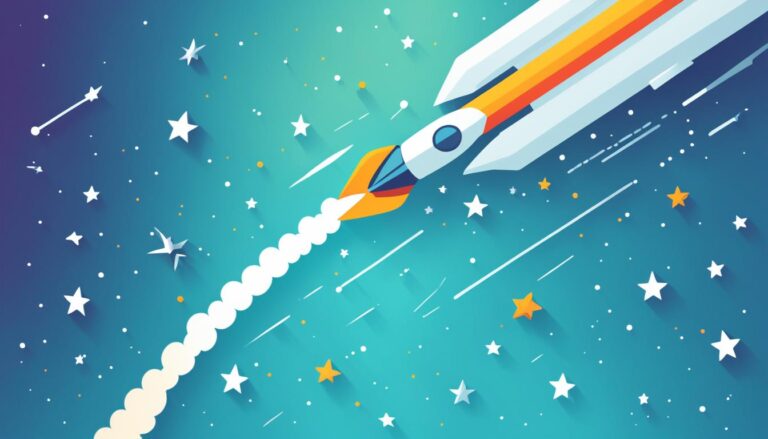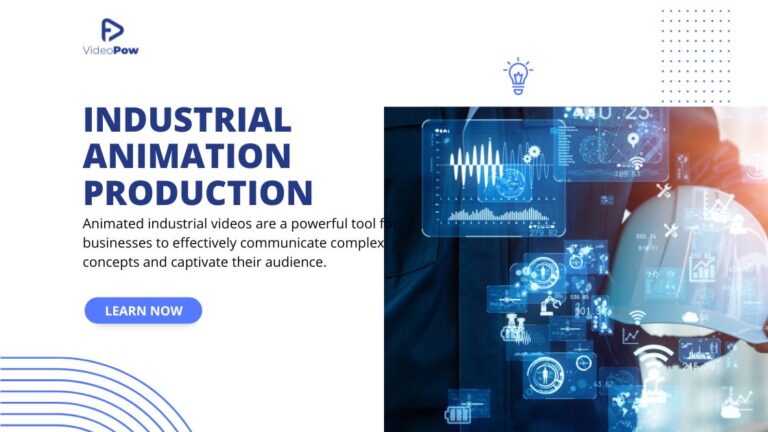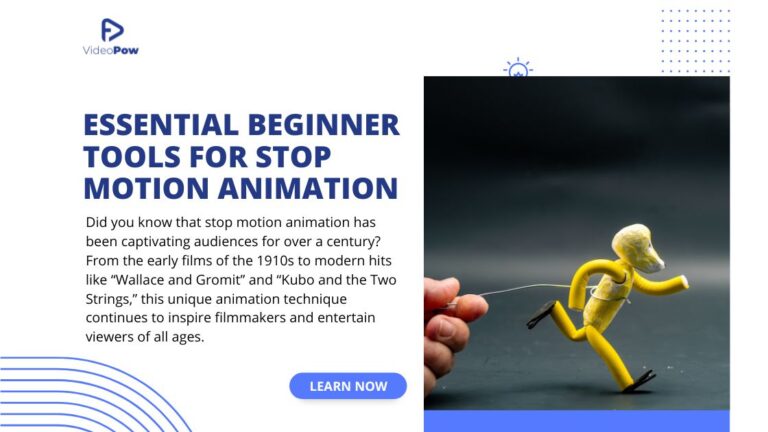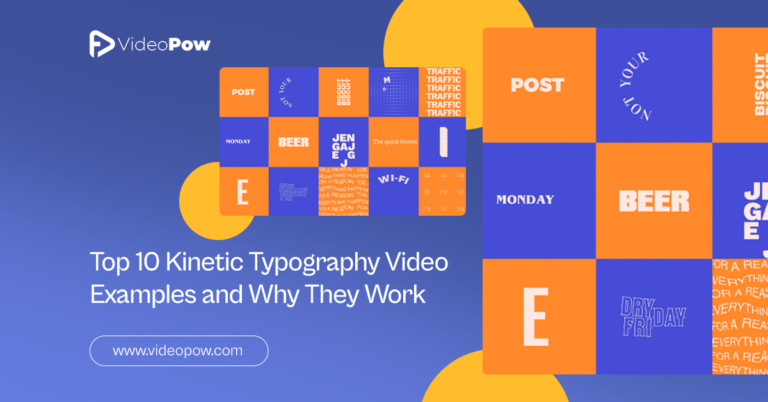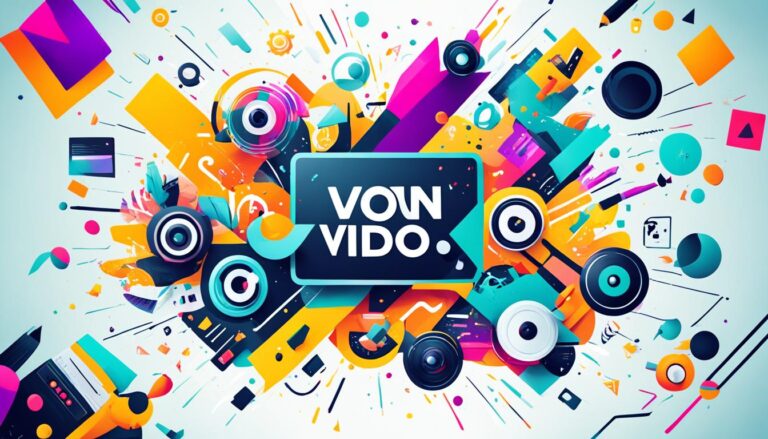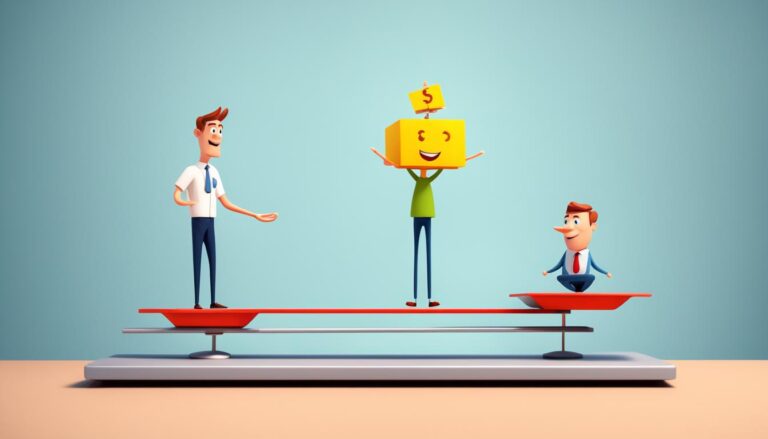Did you know that motion graphics and animation are not the same? While both involve creating moving imagery, there are key differences that set them apart. Understanding these differences can help you choose the right visual approach for your videos and effectively convey your message to your audience.
Unlike animation, which encompasses various forms of moving imagery, motion graphics focus on giving movement to graphic design elements. They are typically used to animate graphic design elements without a specific narrative, making them ideal for presenting facts, emphasizing points, and illustrating concepts. Animation, on the other hand, is more focused on storytelling and cinematic effects, creating emotional narratives and engaging the audience on a deeper level.
Key Takeaways:
- Motion graphics focus on giving movement to graphic design elements, while animation encompasses various forms of moving imagery.
- Motion graphics are best suited for presenting facts and illustrating concepts, while animation is ideal for storytelling and establishing emotional connections.
- Motion graphics are easier and faster to produce compared to animation, making them more cost-effective and time-efficient solutions.
- Motion graphics have a wide appeal and can be easily amended and updated, while animation requires more significant changes and adjustments.
- Choosing between motion graphics and animation depends on the specific requirements, goals, and target audience of a project.
What are Motion Graphics?
Motion graphics refer to the art of giving life and movement to static graphic design elements. By adding animation and motion to shapes, objects, and text, motion graphics create visually engaging and dynamic content. They are often employed to illustrate complex ideas and concepts in a visually appealing manner, leveraging the power of motion to captivate and inform viewers.
Motion graphics can be utilized across various digital platforms, including data visualizations, logos, websites, and more. With their ability to add visual flair and capture attention, motion graphics are particularly effective in conveying hard-to-understand concepts through clear and engaging visuals. Their wide appeal makes them a valuable tool in educational, marketing, and entertainment contexts.
Whether it’s animating a logo for brand recognition, creating informative explainer videos, or designing captivating motion backgrounds, motion graphics offer countless possibilities to enhance visual communication.
What is Animation?
Animation is a broader term that encompasses various techniques for making static objects or images move. It is a creative process that brings life and movement to static elements, captivating audiences with captivating stories and visuals. The possibilities with animation are endless, allowing artists to express their imagination and storytelling skills.
There are several types of animation, each with its unique characteristics and visual styles. Some common types of animation include:
- Hand-drawn Animation: This traditional form of animation involves drawing each frame by hand. It is the foundation of animation and has been used in classic films such as Walt Disney’s “Snow White and the Seven Dwarfs.”
- Computer Generated Imagery (CGI): CGI animation is created digitally using computer software. It allows for realistic 3D visuals, often seen in animated films like Pixar’s “Toy Story.”
- Anime: Anime refers to animation originating from Japan and is known for its distinct art style. It covers a wide range of genres and has a devoted fan base worldwide.
- Claymation: Claymation involves using clay or other modeling materials to create characters and sets. The animator moves the objects in small increments to create the illusion of movement. Popular examples of claymation include Wallace and Gromit and the works of Aardman Animations.
- Motion Graphics: Motion graphics, as mentioned earlier, are a type of animation that focuses on animating graphic design elements. They are often used in video intros, title sequences, and promotional materials.
Animation is not limited to a single medium or platform. It can be found in movies, television shows, advertisements, video games, and even mobile apps. The versatility of animation allows artists to create immersive and engaging experiences for audiences.
Animation is a powerful art form that combines creativity, technical skill, and storytelling to bring characters and worlds to life. It has the ability to evoke emotions, capture imaginations, and communicate complex ideas in a visually compelling way.
Benefits of Animation
Animation offers several advantages over other forms of visual communication:
- Engaging storytelling: Animation allows storytellers to create immersive narratives that captivate audiences and forge emotional connections.
- Visual impact: Animated visuals are often visually captivating and can effectively convey complex concepts or ideas with clarity.
- Versatility: Animation can be adapted to suit various styles, genres, and target demographics, making it a versatile medium for creative expression.
- Endless creativity: Animated characters, worlds, and visual effects are limited only by the imagination of the animator, allowing for limitless creativity and artistic exploration.
- Long-lasting appeal: Animation has a timeless quality that can endure for generations, attracting and entertaining audiences long after its creation.
With its broad range of styles and techniques, animation continues to evolve and push artistic boundaries. It remains a popular and influential medium that empowers artists and captivates audiences around the world.
Motion Graphics vs. Animation: Content and Narrative
When comparing motion graphics and animation, it’s important to highlight the differences in their approach to content and narrative. While both forms involve movement and storytelling, they serve distinct purposes and evoke contrasting emotions.
Motion graphics primarily involve setting abstract objects, text, and graphic design elements in motion. They excel at outlining facts, emphasizing points, and illustrating concepts in a visually engaging manner. Motion graphics are commonly used to present information without the need for a specific narrative or storytelling element. They are effective tools for conveying complex ideas and making them easily understandable through visual aids.
Animation, on the other hand, focuses on creating emotional narratives and character-driven stories. It delves deeper into the art of storytelling and aims to establish a connection with the audience on an emotional level. Animation breathes life into characters and employs cinematic techniques to bring stories to life. It allows for creativity, artistic expression, and a more immersive experience for viewers.
While both motion graphics and animation involve movement, their primary focus and impact differ significantly. Motion graphics are ideal for presenting information, outlining facts, and providing visual aids. They excel at conveying abstract ideas and concepts in a concise and visually appealing manner. Animation, on the other hand, evokes emotions, creates compelling narratives, and establishes a deeper connection with the audience through character development and storytelling techniques.
Now, let’s take a closer look at the contrast between motion graphics and animation in terms of their content and narrative approach.
Motion Graphics:
- Emphasizes graphic design elements and abstract objects
- Outlines facts and presents information visually
- Illustrates concepts and ideas concisely
- Creates visually engaging visual aids
Animation:
- Focuses on storytelling and emotional narratives
- Brings characters to life and develops their personalities
- Establishes a deeper connection with the audience
- Utilizes cinematic techniques and artistic expression
Understanding the difference in content and narrative approach between motion graphics and animation is crucial when deciding which form to employ for a particular project. Whether it’s a need for concise visual aids or a desire to evoke emotions and create compelling narratives, choosing the right approach will result in a more effective and impactful visual experience.

Motion Graphics vs. Animation: Cost and Time
When considering the cost and time factors associated with motion graphics and animation, it becomes evident that there are significant differences between the two.
Motion graphics are generally easier and faster to produce compared to animation. This is primarily attributed to the nature of motion graphics, where graphic design elements are given movement without the need for complex narratives or character animations. The simplicity of motion graphics allows for quicker turnarounds and efficient workflows.
In terms of cost, motion graphics tend to be more cost-effective than animation. The reason behind this is that motion graphics require less complex animation techniques and can be reused multiple times. This reusability factor significantly reduces production costs while maintaining visually appealing results. Businesses and brands with budget constraints can benefit from choosing motion graphics as a cost-effective option for their video production needs.
On the other hand, animation can be more time-consuming and expensive, especially for longer videos or projects that involve script writing, voiceovers, and complex animation styles. Each frame of an animated video needs careful crafting, requiring meticulous attention to detail and a considerable amount of time. Furthermore, animation often involves more extensive pre-production and scripting phases, which add to the overall production time and cost.
| Aspect | Motion Graphics | Animation |
|---|---|---|
| Production Time | Shorter | Longer |
| Production Cost | Lower | Higher |
| Complexity | Simpler | More Complex |
| Reusability | High | Low |
As demonstrated in the table above, motion graphics offer shorter production time, lower production costs, simpler execution, and higher reusability compared to animation. However, this does not diminish the importance and value of animation, which shines in its ability to create immersive storytelling experiences and emotional connections with the audience.
Motion Graphics vs. Animation: Audience and Reusability
When deciding between motion graphics and animation, it’s essential to take into account the target audience and the desired impact on viewers. Both motion graphics and animation have their unique strengths and purposes that cater to different audiences.
Motion graphics have a wide appeal and can be used effectively across various industries and audiences. They are particularly suitable for presenting facts, emphasizing points, and providing visual aids. With their ability to animate graphic design elements, motion graphics excel at simplifying complex information and making it easily understandable.
On the other hand, animation allows for deeper emotional connections and is better suited for storytelling. It has the power to evoke emotions, create engaging narratives, and establish a profound connection between the audience and the content. Animation is commonly used in animated films, commercials, and videos where a higher level of audience engagement is desired.
When considering reusability, motion graphics have an advantage. They can be easily amended and updated to fit different contexts or convey new information. Motion graphics templates can be modified with minor changes to logos, text, or color schemes, allowing for efficient content creation and consistent branding. This reusability makes motion graphics a cost-effective choice for projects with evolving requirements.
On the other hand, animation may require more significant changes and adjustments when repurposing content. It often involves intricate character movements and a complex narrative structure that may need to be redesigned or recreated entirely for a different purpose. While animation offers limitless creative possibilities, it may require more time, resources, and budget to achieve the desired results when compared to motion graphics.
Benefits of Motion Graphics and Animation: Audience and Reusability
In summary, motion graphics have a broad appeal and can be used effectively for audiences across industries. They simplify complex information and emphasize key points, making them suitable for conveying facts and concepts.
Animation, on the other hand, allows for deeper emotional connections through storytelling and is better suited for projects that aim to establish a strong bond with the audience. While animation may require more time and resources, its ability to create immersive narratives and evoke emotions can have a powerful impact.
Furthermore, motion graphics offer enhanced reusability, as they can be easily adapted and updated for different purposes. This flexibility makes motion graphics an efficient choice for projects with evolving content requirements, enabling brands to maintain consistency and make regular updates without significant overhead.
Ultimately, the decision between motion graphics and animation should be based on the specific goals, target audience, and desired impact of the project. Understanding the audience and considering the reusability of the content will help brands make informed choices and create visually compelling and engaging videos.
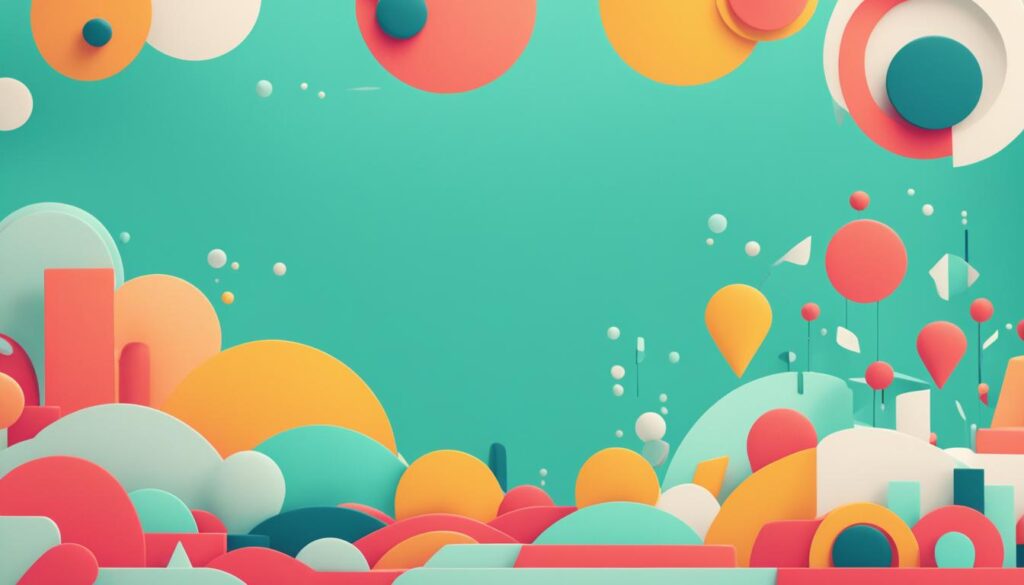
Motion Graphics vs. Animation: Branding
When it comes to branding, both motion graphics and animation offer unique opportunities to showcase a brand’s visual identity and messaging. The choice between motion graphics and animation depends on what best aligns with the brand’s objectives and target audience.
Motion graphics can be produced in various styles, allowing brands to adopt character-based, abstract, or text-centered designs. This versatility enables brands to create visually engaging content that incorporates their brand elements seamlessly. Whether it’s a captivating logo animation or an informative explainer video, motion graphics can bring a brand’s identity to life while conveying key messages effectively.
On the other hand, animation offers a broader range of artistic techniques and styles. From 2D hand-drawn animations to realistic 3D renderings, animation allows brands to tell stories and evoke emotions through characters and narratives. This form of branding appeals to audiences looking for immersive experiences and deeper connections with brands. Animated content can be particularly effective in creating a lasting impression and establishing a strong emotional bond with consumers.
Ultimately, the decision between motion graphics and animation for branding should be based on the brand’s specific objectives, target audience, and the nature of the content being produced. Understanding the strengths and unique qualities of each medium will help brands make informed choices that align with their brand identity and resonate with their audience.
Key Takeaways:
- Motion graphics provide a versatile platform to showcase a brand’s visual identity and messaging.
- Animation allows for storytelling and emotional connections with the audience.
- The choice between motion graphics and animation depends on the brand’s objectives and target audience.
When to Use Motion Graphics
Motion graphics are a powerful tool for visually communicating complex information and capturing the attention of viewers. By incorporating movement and animation into graphic design elements, motion graphics can enhance your messaging and drive engagement. Here are some scenarios where motion graphics excel:
1. Outlining and Emphasizing Facts
Motion graphics are perfect for presenting data, statistics, or any factual information that you need to highlight. Through visually appealing animations, you can break down complex services or products into easily understandable concepts. Whether it’s showcasing the growth of a company’s revenue or illustrating the benefits of a new product, motion graphics can create a compelling visual narrative that captures your audience’s attention.
2. Providing Visual Aids for Complex Ideas
When you need to explain abstract or intricate concepts, motion graphics can simplify the message and make it more accessible to your audience. By visually representing complex ideas through engaging animations, you can enhance understanding and facilitate knowledge retention. Whether it’s demonstrating the inner workings of a technological process or visualizing the steps of a complex workflow, motion graphics can make challenging concepts digestible and engaging.
3. Presenting Information Without a Narrative Element
Unlike animation, which focuses on storytelling and character-driven narratives, motion graphics excel at presenting information without relying on a specific plot or storyline. If you have information that needs to be shared concisely and without the need for a narrative structure, motion graphics are an excellent choice. They offer a visually captivating way of communicating key points, ideas, or instructions effectively.
If you want to engage your audience with visually compelling content, motion graphics are a valuable addition to your marketing toolkit. They can elevate your advertisements, enhance explainer videos, enrich infographics, create eye-catching title cards, and provide captivating moving backgrounds. By leveraging the benefits of motion graphics, you can effectively communicate your message and leave a lasting impression on your audience.
When to Use Animation
Animation is a powerful tool that can elevate storytelling, create emotional connections, and engage the audience on a deeper level. When deciding whether to use animation in your video content, consider the following factors:
- Storytelling: Animation is ideal for projects that require a narrative. It allows you to bring characters to life, introduce plot twists, and evoke emotions through visual storytelling. Whether you’re creating an animated film, a commercial, or a promotional video, animation can help you captivate your audience with compelling narratives.
- Emotional Connections: Animation has the ability to establish profound emotional connections with viewers. By infusing characters with personality, you can create relatable experiences that resonate with your audience. Whether you want to evoke laughter, tears, or joy, animation provides a unique opportunity to connect on a deeply emotional level.
- Creativity and Artistic Expression: Animation offers boundless creative possibilities. It allows you to experiment with various art styles, color palettes, and visual effects to create a unique visual experience. Whether you opt for traditional hand-drawn animation, CGI, or stop-motion techniques, animation enables you to showcase your artistic vision and express your brand’s identity in a visually captivating way.
- Immersive and Cinematic Experience: If you want to transport your viewers into a different world or create a captivating visual journey, animation is the way to go. With its ability to create stunning landscapes, fantastical creatures, and breathtaking action sequences, animation offers a truly immersive and cinematic experience that can captivate audiences of all ages.
Overall, animation provides a powerful medium for storytelling, emotional connection, artistic expression, and creating immersive experiences. Whether you’re aiming to entertain, educate, or inspire, animation can help you engage your audience on a deeper level and leave a lasting impression.
| Benefits of Animation |
|---|
| 1. Engages emotions |
| 2. Allows creative expression |
| 3. Creates immersive experiences |
| 4. Captivates diverse audiences |
| 5. Supports visual storytelling |
Motion Graphics and Animation in Marketing
Both motion graphics and animation have proven to be powerful tools in marketing strategies. The use of videos in marketing has been shown to increase engagement, drive traffic, and improve conversions for brands.
When it comes to motion graphics, their ability to present facts and illustrate points makes them highly effective in conveying information to the audience. Through visually engaging design elements and movement, motion graphics capture attention and deliver messages in a clear and concise manner. They can effectively communicate complex concepts, making them ideal for explaining products, processes, or services.
On the other hand, animation offers a unique way to establish a deeper connection between the brand and the audience by utilizing storytelling techniques. Animation allows for the creation of narratives and the development of emotional journeys through characters and cinematic effects. By tapping into the audience’s emotions, animation can elicit a strong response and leave a lasting impression.
The choice between motion graphics and animation in marketing ultimately depends on the specific goals and messaging of the brand. If the objective is to provide information in a visually engaging manner, motion graphics are a great choice. However, if the brand wants to establish a strong emotional connection and create a memorable experience for the audience, animation can be the key.
| Motion Graphics in Marketing | Animation in Marketing |
|---|---|
| Effective for presenting facts and illustrating points | Establishes a deeper connection through storytelling |
| Communicates complex concepts in a clear and concise manner | Creates emotional journeys and elicits strong responses |
| Ideal for explaining products, processes, or services | Leaves a lasting impression and provides a memorable experience |
Ultimately, the decision to use motion graphics or animation in marketing should be based on the brand’s specific objectives, target audience, and desired impact. By understanding the strengths and suitability of each approach, brands can effectively leverage motion graphics and animation to create compelling marketing campaigns.
Conclusion
Motion graphics and animation are two distinct forms of moving imagery that serve different purposes. Motion graphics focus on giving movement to graphic design elements and are best suited for outlining facts and providing visual aids. Animation, on the other hand, focuses on storytelling and crafting emotional narratives through characters and cinematic techniques.
The choice between motion graphics and animation depends on the specific requirements, goals, and target audience of a project. For projects that require visually explaining complex ideas or emphasizing key points, motion graphics offer an effective solution. Their ability to add movement to graphic design elements helps make information more engaging and accessible.
On the other hand, animation is the preferred choice when the goal is to create a deeper connection with the audience through storytelling and emotional narratives. Animation allows brands to bring characters to life and immerse viewers in imaginative worlds, fostering a stronger emotional connection and engagement.
Understanding the differences between motion graphics and animation is crucial for brands to make informed decisions when choosing the most suitable visual approach for their videos. By carefully considering their project requirements, goals, and target audience, brands can leverage the power of motion graphics or animation to effectively communicate their messages and achieve their desired impact.
FAQ
What is the difference between motion graphics and animation?
Motion graphics focus on giving movement to graphic design elements, while animation is a broader term that encompasses various forms of moving imagery.
What are motion graphics?
Motion graphics are a type of animation that involve animating graphic design elements without a specific narrative, often used to illustrate complex ideas visually.
What is animation?
Animation is a broader term that encompasses various techniques for making static objects or images move, including hand-drawn cartoons, CGI, anime, claymation, and motion graphics.
How do motion graphics and animation differ in content and narrative?
Motion graphics focus on outlining facts and illustrating concepts, whereas animation focuses on crafting emotional narratives and character-driven stories.
How do motion graphics and animation differ in cost and time?
Motion graphics are generally easier and faster to produce compared to animation, which can be more time-consuming and expensive, especially for longer videos.
How do motion graphics and animation differ in audience and reusability?
Motion graphics have a wide appeal and can be used for a variety of industries and audiences, while animation allows for deeper emotional connections but may require more significant changes and adjustments for reusability.
How do motion graphics and animation differ in terms of branding?
Both can be produced in various styles that align with a brand’s visual identity, with motion graphics often adopting character-based, abstract, or text-centered styles, and animation being done in 2D or 3D and following different art forms.
When should I use motion graphics?
Motion graphics are best used when there is a need to outline or emphasize facts, provide visual aids for complex ideas, or present information without a narrative or storytelling element.
When should I use animation?
Animation is ideal when there is a need for storytelling, emotional connections, and deeper engagement with the audience, commonly used in animated films, commercials, and videos that require a more immersive and cinematic experience.
How effective are motion graphics and animation in marketing strategies?
Both motion graphics and animation have proven to be effective in marketing strategies, with videos in general yielding better engagement, traffic, and conversions for brands. Motion graphics are particularly useful for presenting facts and illustrating points, while animation helps establish a deeper connection between the brand and the audience through storytelling.
What are the key differences between motion graphics and animation?
Motion graphics focus on giving movement to graphic design elements, while animation focuses on storytelling and crafting emotional narratives. The choice between the two depends on specific requirements, goals, and target audiences.


